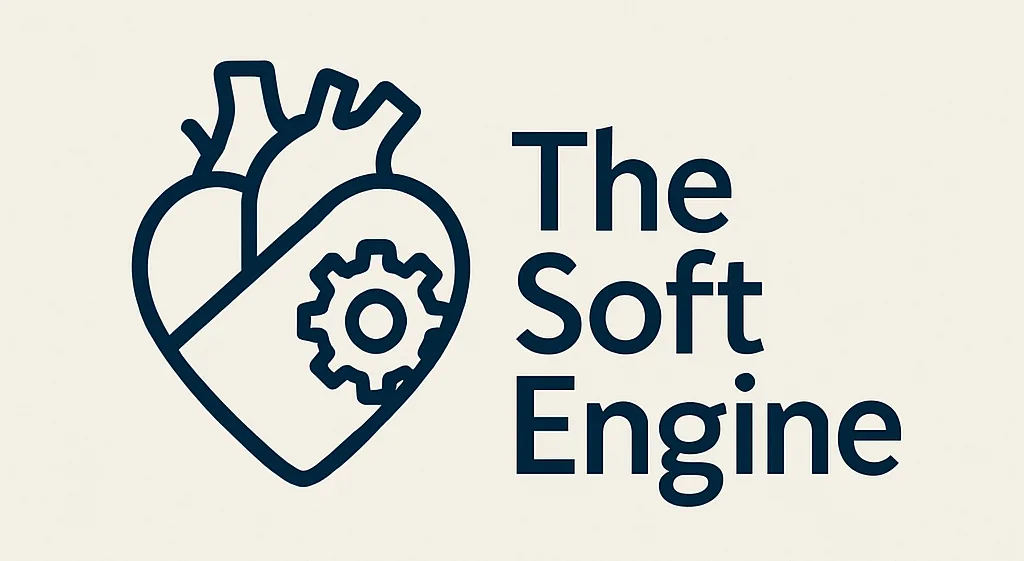Throughout the long history of productivity, we’ve been told that productivity is motivation. And not having motivation is a moral failing.
But, in our experience here at The Soft Engine, productivity is choreography more than anything else.
Over the past few years, behavioral scientists have mapped this rhythm in stunning detail. Research from the American Psychological Association and Harvard Business Review shows that high performers don’t chase intensity but rather engineer consistency.
Each small routine removes a decision from your day. And over time, those micro-decisions add up to something powerful: mental space. When the brain isn’t busy negotiating what comes next, it can finally focus on what matters now.
Once they’re in place, productivity feels less like a fight and more like flow. Here’s how to do just that.
Daily Habits for Productivity Content
The Technical Stuff: Why Daily Habits Drive Lasting Productivity
(Skip to the good stuff if this isn’t your speed)
Habits are the nervous system’s shortcut for conserving energy. Each one links a cue, a behavior, and a reward into a single automated loop.
According to Wendy Wood at the University of Southern California, nearly half of what we do each day runs on this kind of autopilot.
If those loops serve your priorities, they quietly compound into progress. If they don’t, they quietly erode it.
In other words, productivity thrives on predictability.
The more consistent your environment, the easier it becomes for your brain to slip into focus mode without the friction of decision-making.
That’s why top performers ritualize their focus periods. They sit at the same desk, start with the same song, and open the same dashboard. Neuroscientists call this context-dependent learning: the brain linking physical and sensory cues to a specific mental state.
The Science of Habit Formation and Focus
Modern habit science goes far beyond “just repeat it.”
Frameworks like Fogg’s Behavior Model (Behavior = Motivation × Ability × Prompt) explain why some habits stick and others fade: all three ingredients must align.
Without a clear cue, an easy action, and a compelling reason, the loop collapses.
When the behavior happens under the same conditions each time, automaticity rises fast.
“If-then” planning is another proven accelerator. Telling your brain, “If it’s 8 a.m., I open my task board,” binds intention to context.
Finally, reinforcement matters. The brain learns from closure, not just effort.
Each time you complete a meaningful task—finish a draft, close your laptop intentionally—you get a dopamine pulse that marks the loop as worth repeating.
That biochemical reward cements the pattern faster than external pressure ever could.
Explain Like I’m Five: How To Form Habits To Be More Productive
Picture your brain as a browser with too many tabs open. One’s playing music you can’t find. Another’s frozen mid-scroll. A third one’s just… buffering your motivation.
Habits are how you hit “save session” and close the chaos.
They take the things you do every day, turn them into background code. Once those loops are running automatically, your brain doesn’t have to load the same decisions over and over again.
At The Soft Engine, we call this thinking less to create more.
Every small ritual, whether that’s your morning setup or your end-of-day shutdown, is a little automation for your mind.
It clears cognitive clutter, so your attention can do what it loves most: making things happen.

7 of the Best Daily Habits to Be More Productive Every Day
Here are the habits that actually move the needle. Supported by data, not trend pieces.
1. Start Your Day with Movement, Sunlight, and Hydration
We’re basically houseplants with deadlines. Before your brain can focus, your body needs fuel: movement, sunlight, and water.
Here’s how to stack them in under fifteen minutes:
- Get light first. Step outside within 10–20 minutes of waking—no sunglasses yet. Two to ten minutes of natural light helps reset your circadian rhythm and jump-starts alertness hormones. If it’s dark, turn on the brightest indoor light you can or use a sunrise lamp.
- Move a little. You don’t need a workout. Try 20 squats, a stretch, or a short walk while the coffee brews. A 2024 meta-analysis found that even five minutes of movement improves attention and working memory.
- Hydrate before caffeine. Your body loses water overnight. Drink a full glass (or two) before your first coffee to restore alertness and avoid that midmorning brain fog.
That’s it. Ten minutes, three cues, and your nervous system knows it’s showtime.
2. Plan Top Tasks Using the Eisenhower Matrix
The simple Eisenhower Matrix four-box chart is still the best focus tool ever drawn on a napkin.
Draw a simple grid with Urgent / Not Urgent across the top and Important / Not Important down the side.
Now sort your tasks into those four boxes:
| Urgent | Not Urgent | |
| Important | Do it today → critical calls, deadlines, client deliverables | Schedule it → planning, skill-building, strategy |
| Not Important | Delegate it → admin, reports someone else can handle | Delete it → scrolling, busywork, “just-checking-in” emails |
Here’s how to make it work fast:
- Start your day by listing everything that’s on your mind, from major projects to small chores.
- Drop each item into a box. Be ruthless for five minutes.
- Tackle Quadrant I first (urgent + important).
- Schedule Quadrant II (important + not urgent), that’s where progress actually happens.
- Delegate or cut everything in Quadrants III and IV.
If you repeat this each morning or week, you’ll see a pattern: most “emergencies” aren’t.
3. Focus on High-Value Work with the Pareto Principle
The Pareto Principle says that 80% of your results usually come from about 20% of your actions. The trick is figuring out which 20%.
Start simple:
- Look at your week and circle the tasks that actually moved something forward — revenue, visibility, progress, peace of mind.
- Now highlight the ones that drained time but didn’t change outcomes. That’s your 80% of noise.
Once you see the pattern, protect the 20% with your life.
Batch or automate the low-impact tasks. Schedule your top 20% i.e., the work that truly matters, for when your energy peaks.
4. Manage Energy with Breaks and Work Blocks
Time management tells you when to work.
Energy management decides how well you work.
Most people hit a natural energy dip every 60–90 minutes, which is your brain’s built-in ultradian rhythm. Instead of pushing through it (which is futile for most of us), use it.
Here’s how:
- Set a timer for 75 minutes. That’s one focus block.
- Work on a single task only. No toggling between tabs.
- When the timer goes off, step away for 5–10 minutes.
- Move your body (walk, stretch, refill water).
- Look outside to reset your visual focus.
- Skip scrolling—your brain needs contrast, not noise.
- Start the next block only after that short reset.
If you stack four of these cycles, you’ve worked roughly six focused hours, the realistic maximum most people can sustain in a day without burnout.
5. Use Evening Routines to Reset Your Mind
A productive day starts the night before. Your brain needs a shutdown signal. Something that says, “We’re done solving things for today.”
Without it, your mind keeps spinning long after you’ve closed your laptop.
Here’s how to design a simple wind-down that actually works:
- Set a “soft stop” time. About 30–60 minutes before bed, switch from input to output—no email, no Slack, no doom-scrolling.
- Dim the lights and screens. Blue light delays melatonin, which means later sleep and foggier mornings. Try lamp light or night mode instead of overheads.
- Empty your head. Write down what’s unfinished or what’s on deck for tomorrow. It’s psychological closure.
- Do one relaxing, predictable thing. Stretch, wash your face, read five pages—same order, same time. Repetition trains your nervous system to downshift automatically.
You don’t need a 10-step routine or fancy rituals. Just a few consistent cues that tell your brain the day is ending.
6. Build Daily Habits with Habit Stacking
Starting from scratch is hard. Building on what already exists is easy. That’s the logic behind habit stacking, which involves pairing a new behavior with one you already do automatically.
Here’s how to do it in three quick steps:
- Pick a stable anchor. Something you do every day without fail: making coffee, brushing your teeth, opening your laptop.
- Attach one micro-action. Right after your anchor, add a two-minute habit. For example:
- After I pour coffee → I review today’s top three tasks.
- After I brush my teeth → I put on workout clothes.
- After I open my laptop → I take one deep breath before checking my email.
- Keep it small and specific. Complexity kills consistency. If the action takes longer than two minutes, shrink it.
7. Track Your Progress to Make Habits Stick
What you track, you repeat. Not because the chart nags you, but because progress is addictive.
Here’s how to track without turning it into a second job:
- Choose your format. Paper calendar, phone app, Notion template. It really doesn’t matter. What counts is visibility.
- Pick a simple metric. “Did I do it today?” works better than “How well did I do it?” Binary is better than perfection.
- Review once a week. Glance back and notice streaks or patterns. Did you skip weekends? Lose momentum on travel days? That reflection turns data into insight.
A 2024 Frontiers in Psychology review found that even light self-monitoring boosts habit consistency. Seeing those marks pile up reinforces identity: I’m someone who follows through.
What Is the 333 Rule for Productivity?
The 333 rule for productivity is a simple daily framework to focus without burnout. It divides your day into 3 hours of deep work, 3 quick tasks, and 3 personal actions like movement or learning. This balance of focus, flexibility, and rest makes it one of the easiest daily habits for productivity to maintain, especially for remote or hybrid workers.
What Is the 80/20 Rule for Productivity?
The 80/20 rule (Pareto Principle) says that about 80% of your results come from 20% of your actions. To apply it: identify tasks that create measurable impact—such as revenue, progress, or creativity—and schedule those during your peak energy hours. The rest can often be automated, delegated, or trimmed. Harvard Business Review calls this selective focus “a hallmark of high performers.”
What Are Daily Productivity Habits?
Daily productivity habits are small, consistent actions that automate focus and reduce decision fatigue. Examples include starting your day with movement and sunlight, using the Eisenhower Matrix for planning, working in 60- to 90-minute focus blocks, and tracking your progress weekly. According to the American Psychological Association, consistent routines improve attention, self-control, and stress resilience—key drivers of long-term productivity.
What Is an Example of a Productive Daily Habits?
A productive daily routine balances focus, recovery, and planning. Here’s a proven structure:
Morning: get sunlight within 20 minutes of waking, hydrate, and list your top three priorities.
Midday: work in 75-minute blocks with 5-minute breaks; batch emails once or twice.
Evening: write a short to-do list, dim screens, and wind down for sleep.
This pattern aligns with your circadian rhythm and supports energy-based productivity throughout the day.
How Can I Stay Productive All Day Long?
To stay productive all day, manage energy, not just time. Focus on high-value work when your alertness peaks, take micro-breaks every 60–90 minutes, and keep hydrated. Avoid context switching by batching messages and tasks. Research from APA and Frontiers in Psychology shows that regular breaks and energy management maintain focus longer than continuous effort.
Final Words: Your Daily Habits Are the Future of Your Focus
The people who get things done are the ones designing lives that let focus happen naturally. Small, repeatable action that builds the invisible scaffolding that keeps your attention steady when motivation dips.
These daily habits for productivity are quiet, almost boring. But that’s the point. When the basics are automated, your best energy goes where it counts—on creative work, clear thinking, and actual rest.
At The Soft Engine, we believe your attention is your most renewable resource. Protect it, automate what drains it, and build rituals that serve it.
Before you stack another habit or download another planner, start with data.
Our Soft Engine Productivity Assessment helps you find your true baseline and helps you figure out where you need to focus your efforts. It’s completely free, no sign-up, and will only take you a few minutes.

